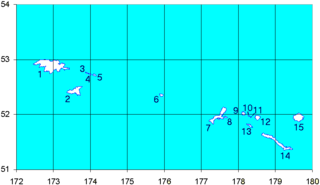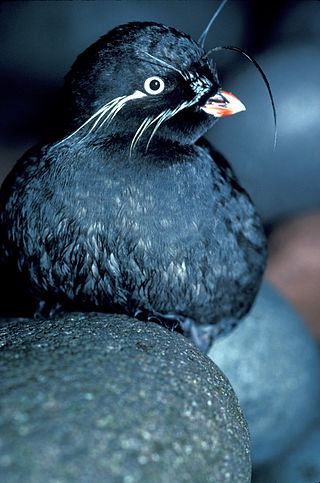
Palmyra Atoll, also referred to as Palmyra Island, is one of the Northern Line Islands. It is located almost due south of the Hawaiian Islands, roughly one-third of the way between Hawaii and American Samoa. North America is about 3,300 miles northeast and New Zealand the same distance southwest, placing the atoll at the approximate center of the Pacific Ocean. The land area is 4.6 sq mi (12 km2), with about 9 miles (14 km) of sea-facing coastline and reef. There is one boat anchorage, known as West Lagoon, accessible from the sea by a narrow artificial channel and an old airstrip; during WW2 it was turned into Naval Air Station for several years and used for training and refueling. It was shelled by a submarine in December 1941, but was not the site of a major battle.

The Pribilof Islands are a group of four volcanic islands off the coast of mainland Alaska, in the Bering Sea, about 200 miles (320 km) north of Unalaska and 200 miles (320 km) southwest of Cape Newenham. The islands are part of the Alaska Maritime National Wildlife Refuge. The Siberian coast is roughly 500 miles (800 km) northwest. About 77 square miles (200 km2) in total area, they are mostly rocky and are covered with tundra, with a population of 572 as of the 2010 census.

The United States Fish and Wildlife Service, also known by the acrnonyms USFWS or FWS, is an agency within the United States Department of the Interior dedicated to the management of fish, wildlife, and natural habitats. The mission of the agency is "working with others to conserve, protect, and enhance fish, wildlife, plants and their habitats for the continuing benefit of the American people."

Kiska is one of the Rat Islands, a group of the Aleutian Islands of Alaska. It is about 22 miles (35 km) long and varies in width from 1.5 to 6 miles. It is part of Aleutian Islands Wilderness and as such, special permission is required to visit it. The island has no permanent population.

Unimak Island is the largest island in the Aleutian Islands chain of the U.S. state of Alaska.

The Rat Islands are a group of American volcanic islands in the Aleutian Islands in southwestern Alaska, between Buldir Island and the Near Islands group to its west, and Amchitka Pass and the Andreanof Islands group to its east. The largest islands in the group are, from west to east, Kiska, Little Kiska, Segula, Hawadax or Kryssei, Khvostof, Davidof, Little Sitkin, Amchitka, and Semisopochnoi. The total land area of the Rat Islands is 360.849 sq mi (934.594 km2). None of the islands are inhabited at present, but at least Amchitka Island was an Aleut territory until the end of the eighteenth century.

The Alaska Maritime National Wildlife Refuge is a United States National Wildlife Refuge comprising 2,400 islands, headlands, rocks, islets, spires and reefs in Alaska, with a total area of 4.9 million acres (20,000 km2), of which 2.64 million acres (10,700 km2) is wilderness. The refuge stretches from Cape Lisburne on the Chukchi Sea to the tip of the Aleutian Islands in the west and Forrester Island in the southern Alaska Panhandle region in the east. The refuge has diverse landforms and terrains, including tundra, rainforest, cliffs, volcanoes, beaches, lakes, and streams.

Semisopochnoi Island or Unyak Island is part of the Rat Islands group in the western Aleutian Islands of Alaska. The island is uninhabited and provides an important nesting area for maritime birds. The island is of volcanic origin, containing several volcanoes including Mount Young. It has a land area of 85.558 square miles, measuring 11 miles (18 km) in length and 12 miles (20 km) in width.

The ecological restoration of islands, or island restoration, is the application of the principles of ecological restoration to islands and island groups. Islands, due to their isolation, are home to many of the world's endemic species, as well as important breeding grounds for seabirds and some marine mammals. Their ecosystems are also very vulnerable to human disturbance and particularly to introduced species, due to their small size. Island groups, such as New Zealand and Hawaii, have undergone substantial extinctions and losses of habitat. Since the 1950s several organisations and government agencies around the world have worked to restore islands to their original states; New Zealand has used them to hold natural populations of species that would otherwise be unable to survive in the wild. The principal components of island restoration are the removal of introduced species and the reintroduction of native species.

Buldir Island is a small island in the western Aleutian Islands of the U.S. state of Alaska. It is 4.3 miles (6.9 km) long and 2.5 miles (4.0 km) wide with an area of 7.4482 square miles (19.291 km2). Buldir is farther from the nearest land than any other Aleutian Island. Its nearest neighbors are Kiska in the Rat Island group, 68 miles (109 km) to the east, and Shemya in the Near Island group, 64 miles (103 km) to the west. Buldir Island is uninhabited. It is part of the Alaska Maritime National Wildlife Refuge. It has been designated a Research Natural Area.

Lehua Island is a small, crescent-shaped island in the Hawaiian islands, 0.7 miles (1.1 km) north of Niʻihau, due west of Kauai. The uninhabited, 285-acre (1.15 km2) barren island is a tuff cone which is part of the active Niʻihau volcano. Lehua was one of the first five islands sighted by Captain James Cook in 1778 which he spelled as "Oreehoua".

Brodifacoum is a highly lethal 4-hydroxycoumarin vitamin K antagonist anticoagulant poison. In recent years, it has become one of the world's most widely used pesticides. It is typically used as a rodenticide, but is also used to control larger pests such as possums.

Aethia is a genus of four small (85–300g) auklets endemic to the North Pacific Ocean, Bering Sea and Sea of Okhotsk and among some of North America's most abundant seabirds. The relationships between the four true auklets remains unclear. Auklets are threatened by invasive species such as Norway rats because of their high degree of coloniality and crevice-nesting.

Castle Rock National Wildlife Refuge is 0.5 miles (0.80 km) offshore from Crescent City in northern California. This coastal rock covers approximately 14 acres (57,000 m2), and rises steeply 335 feet (102 m) above sea level. The refuge provides an important sanctuary for the Aleutian cackling goose and nesting seabirds.
The Desecheo National Wildlife Refuge is a National Wildlife Refuge in Puerto Rico. It is part of the Caribbean Islands National Wildlife Refuge Complex.

The Aleutian Islands, also called the Aleut Islands or Aleutic Islands and known before 1867 as the Catherine Archipelago, are a chain of 14 large volcanic islands and 55 smaller islands. Most of the Aleutian Islands belong to the U.S. state of Alaska, but some belong to the Russian federal subject of Kamchatka Krai. They form part of the Aleutian Arc in the Northern Pacific Ocean, occupying a land area of 6,821 sq mi (17,666 km2) and extending about 1,200 mi (1,900 km) westward from the Alaska Peninsula toward the Kamchatka Peninsula in Russia, and act as a border between the Bering Sea to the north and the Pacific Ocean to the south. Crossing longitude 180°, at which point east and west longitude end, the archipelago contains both the westernmost part of the United States by longitude and the easternmost by longitude. The westernmost U.S. island in real terms, however, is Attu Island, west of which runs the International Date Line. While nearly all the archipelago is part of Alaska and is usually considered as being in the "Alaskan Bush", at the extreme western end, the small, geologically related Commander Islands belong to Russia.

Seabirds include some of the most threatened taxa anywhere in the world. For example, of extant albatross species, 82% are listed as threatened, endangered, or critically endangered by the International Union for Conservation of Nature. The two leading threats to seabirds are accidental bycatch by commercial fishing operations and introduced mammals on their breeding islands. Mammals are typically brought to remote islands by humans either accidentally as stowaways on ships, or deliberately for hunting, ranching, or biological control of previously introduced species. Introduced mammals have a multitude of negative effects on seabirds including direct and indirect effects. Direct effects include predation and disruption of breeding activities, and indirect effects include habitat transformation due to overgrazing and major shifts in nutrient cycling due to a halting of nutrient subsidies from seabird excrement. There are other invasive species on islands that wreak havoc on native bird populations, but mammals are by far the most commonly introduced species to islands and the most detrimental to breeding seabirds. Despite efforts to remove introduced mammals from these remote islands, invasive mammals are still present on roughly 80% of islands worldwide.

Island Conservation is a non-profit organization with the mission to prevent extinctions by removing invasive species from islands. Island Conservation has therefore focused its efforts on islands with species categorized as Critically Endangered and Endangered on the IUCN's Red List. Working in partnership with local communities, government management agencies, and conservation organizations, Island Conservation develops plans and implements the removal of invasive alien species, and conducts field research to document the benefits of the work and to inform future projects.

The Aleutian Islands World War II National Monument is a U.S. national monument in the Aleutian Islands of Alaska. It is located on three islands in the Alaska Maritime National Wildlife Refuge. It was designated as part of World War II Valor in the Pacific National Monument by an executive order of George W. Bush on December 5, 2008, with sites in Alaska, California, and Hawaii. The John D. Dingell, Jr. Conservation, Management, and Recreation Act, signed into law March 12, 2019, separated the national monument into separate units in each state. It is managed by the United States Fish and Wildlife Service.


















